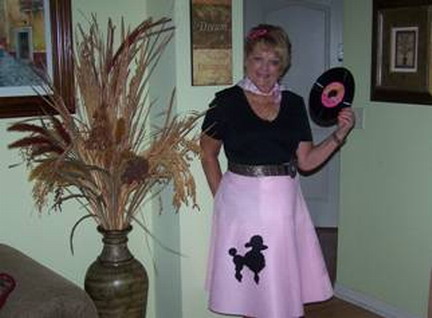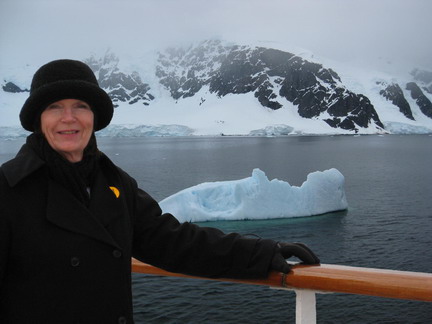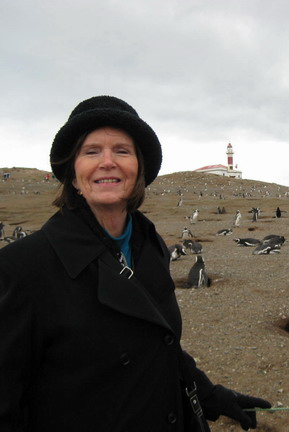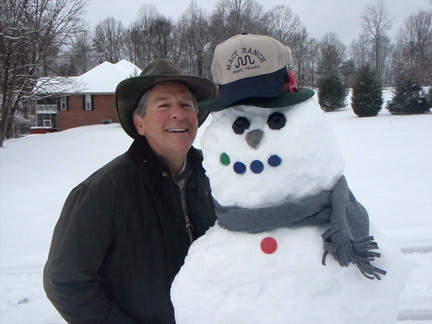|
|
 Before the remote control and long before cable, during our high school years we watched
favorites like BOB HOPE, ED SULLIVAN, I LOVE LUCY, MILTON BERLE, PERRY MASON, LASSIE,
RED SKELTON, HOWDY DOODY, WHAT'S MY LINE and THE LONE RANGER, all in beautiful black & white
on 13" screens. Here is the first group of a long list of other TV shows you may remember
enjoying (when your homework was done and your parents said it was okay).
More will follow in upcoming newsletters.
* Indicates the shows that originated as popular radio programs.
JACKIE GLEASON -His musical variety hour was highlighted by weekly episodes of "The
Honeymooners", with Jackie as bus driver Ralph Cramden, Audrey Meadows as
his better half Alice, Art Carney as neighbor/sewer worker Ed Norton and
Joyce Meadows as Ed's wife Trixie. They are still hilarious today!
*BIG TOWN -Patrick McVey as crime reporter (for the Illustrated Press) Steve Wilson
and Jane Nigh as society writer Lorelei Kilbourne.
I REMEMBER MAMA -Heartwarming stories of a Norwegian family adjusting to life in a large
American city in the early 1900's. The cast included Peggy Wood (Mama),
Judson Laire (Papa) and a young Dick Van Patten (Nels).
THE GARRY MOORE SHOW -There were both daytime and evening shows featuring this genial
emcee with the crew cut. Durwood Kirby was his humorous announcer,
and songs were provided by Ken Carson and Denise Lor. Garry
later introduced a young performer named Carol Burnett.
I'VE GOT A SECRET -Garry Moore also presided over this Goodson-Todman produced show,
featuring panelists Jayne Meadows, Steve Allen, Betsy Palmer, Henry Morgan
and others trying to guess the secrets that guests whispered in Garry's ear.
I MARRIED JOAN -Comedienne Joan Davis as the scatterbrained wife of domestic
court judge Jim Backus.
LIBERACE -The flamboyantly-dressed pianist and his candelabrum, backed by the orchestra
and violin of his brother George.
MEET MR. McNUTLY -The trials and tribulations of a drama professor at an all-girl college,
played by Ray Milland (the name was later changed to "McNulty").
*ADVENTURES OF SUPERMAN -George Reeves became typecast as the bullet-proof hero,"who,
disguised as mild-mannered reporter Clark Kent, fights a
never-ending battle for truth, justice and the American way".
Phyllis Coates first played Lois Lane, followed by Noel Neil.
John Hamilton was Daily Planet editor Perry White ("Great Caesar's
ghost!"), Jack Larsen was photographer Jimmy Olsen and
Robert Shayne was Police Inspector Henderson.
*AMOS AND ANDY -A huge favorite in its day, but now unfortunately considered politically
incorrect. Tim Moore was George "Kingfish" Stevens, Ernestine Wade was his
wife Sapphire, Alvin Childress was Amos Jones, Spencer Williams Jr. was
Andy Brown, Horace Stewart was the janitor Lightnin' and Johnny Lee was
the lawyer Algonquin J. Calhoun. The sponsor was Blatz Beer.
THE BIG TOP -A Saturday regular with Ringmaster Jack Sterling introducing circus acts
and featuring a young Ed McMahon, unrecognizable in clown face and attire.
SUPER CIRCUS -A similar weekly show, co-hosted by comedian Jerry Colonna and blonde
Mary Hartline. Gables High's own baton-twirling SANDY WIRTH (class of 54)
became a semi-regular.
*ADVENTURES OF OZZIE & HARRIET -Everyday situations encountered by the Nelsons (what did
Ozzie do for a living?). Viewers watched David and Ricky
grow up over the years. Don DeFore played their neighbor
"Thorny" Thornberry.
*CAPTAIN MIDNIGHT -Ovaltine sponsored this Saturday morning favorite, with Richard Webb
in the title role and Sid Melton as his jet mechanic Ichabod Mudd.
THE TODAY SHOW -Beginning in 1952, with host Dave Garroway. Regulars included announcer
Jack Lescoulie and newsman Frank Blair, along with Betty Furness, comedians
Bob (Elliott) and Ray (Goulding) and chimp J. Fred Muggs.
*THE LIFE OF RILEY -Jackie Gleason played Chester A. Riley for only one season, then
was replaced for the duration by William Bendix, the actor most
associated with the role. ("What a revoltin' development this is!")
DANGEROUS ASSIGNMENT -Brian Donlevy as international troubleshooter Steve Mitchell.
THE BIG PAYOFF -Quizmaster Randy Merriman and former Miss America Bess Myerson guided
contestants through question and answer "stunt rounds".
MY LITTLE MARGIE -Gale Storm as Margie Albright and Charles Farrell as her father
Vern, with Clarence Kolb as his grouchy boss Mr. Honeywell and
Gertrude Hoffman as their kindly neighbor Mrs. Odettes.
PANTOMIME QUIZ -Mike Stokey hosted two competing teams of movie and TV celebrities playing
charades (later known as "Stump The Stars").
MAKE ROOM FOR DADDY -Danny Thomas as a nightclub entertainer, Jean Hagen as his wife
Margaret,and their kids Sherry Jackson (Terry) and Rusty Hamer (Rusty).
OMNIBUS -Sunday afternoon educational anthology series, hosted by Alistair Cooke.
THE PEOPLE'S CHOICE -Jackie Cooper as a city councilman "Sock" Miller, with running
commentary by his basset-hound Cleo (voiced by Mary Jane Croft).
*THE CISCO KID -Duncan Renaldo as "O. Henry's Robin Hood Of The Old West" and
Leo Carillo as Pancho ("Let's went"), in the first TV series to be filmed
in color, but broadcast at the time in black & white.
YOU'LL NEVER GET RICH -Phil Silvers as Army con-artist Sgt. Ernie Bilko, with Paul Ford as
Colonel Hall, his exasperated commanding officer.
MEET MILLIE -Elena Verdugo as career girl Millie, Florence Halop as her mother Mrs.
Bronson, and Marvin Kaplan as her "nerd" (before the word was coined) friend,
Alfred E. Prinzmetal.
ADVENTURES OF ROBIN HOOD -British actor Richard Greene led his merry men against the
evil Prince John (a then up-and-coming Donald Pleasance).
KUKLA, FRAN & OLLIE -"Straight man" Fran Allison interracted for 15 minutes daily
with Burr Tilstrom's puppet creations, round-nosed little Ollie
and his wacky one-toothed dragon friend Kukla.
And, of course, the daytime soaps (most adapted from long-running radio shows):
LOVE OF LIFE, THE GUIDING LIGHT, PORTIA FACES LIFE, ROAD OF LIFE, SEARCH FOR TOMORROW,
THE SECRET STORM,
Watch for the final Part Three of these TV memories in the next newsletter.
NOTE: Many of these classic shows are available on DVD (at very reasonable prices) from
Nina's Discount Oldies, based in Narberth, Pa. Visit them online at www.oldies.com
or call them for a free catalog at 1-800-336-4627.
They are also an excellent source for hard-to-find movies on DVD and music CD's
of all genres from the past.
|
|
|
|
In 1986 the Junior League of Miami published a booklet which was a guide to historic sites in Coral
Gables. There were two self-guided walking tours which included maps. They also included the entrances, plazas and fountains,
the 7 villages, and other points of interest. The following is part six from that booklet.
A Driving Tour to the Seven Villages
This self-guided tour may be completed by driving to the various locations given for each "village".
THE VILLAGES
To provide diversity to Coral Gables' Mediterranean architecture, George Merrick scattered foreign "villages" throughout the city. Today there are
seven villages. Originally many more were planned and included English, Moorish, Persian and Swedish Villages.
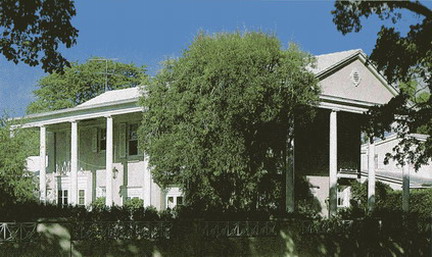 COLONIAL VILLAGE
COLONIAL VILLAGE
Santa Maria – John and Coulton Skinner – 1925
Driving down Santa Maria is reminiscent of the antebellum Deep South. These lovely homes were planned in the Florida Pioneer style when the need
for cooling breezes was most important, and buildings were placed with that in mind. Inspired by the Greek Revival period, tall, white pillars,
two-story porticoes, wide, cool verandas, slate roofs and white picket fences adorn these gracious mansions.
These Georgian-styled homes were designed with large, airy halls, spacious rooms with vaulted ceilings, separate guest suites and maids' quarters.
All of the homes back up to the Riviera Golf Course, this section of which was originally part of the Biltmore Golf Course. The residences were built
by the Myers Y. Cooper Company for the American Building Corporation.
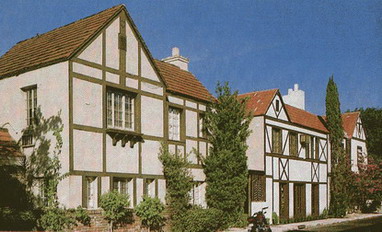 FRENCH NORMANDY VILLAGE
FRENCH NORMANDY VILLAGE
Le Jeune Road and the 400 block of Viscaya Avenue – John and Coulton Skinner – 1926
This quaint village of eleven townhouses is an eloquent rendering of the French Normandy architecture found in fifteenth century towns in England
and France. The houses are constructed of hollow tile, poured concrete, stucco walls supported with dark brown timber beams, and flat shingled roofs.
Height varies from one to two and one-half stories, with upper stories overhanging lower stories to increase living space.
As Merrick intended, these residences are family dwellings, However, in the 1930s the units served as men's dormitories and later as fraternity
houses. Soldiers were quartered here during World War II.
 CHINESE VILLAGE
CHINESE VILLAGE
5100 blocks of Riviera Drive and Menendez, Castania, Maggiore and Sansovino Avenues – Henry Killiam Murphy – 1926
The Chinese Village is made up of eight Oriental residences. These two-story homes are brightly trimmed and roofed in red, yellow, blue, and green.
Decorative gates and walls, which join the residences and afford securuty as well as a sense of communal living, are typical Chinese style.
Characteristics include carved wooden balconies, lattice work on windows, and curving tiled roofs. Various animals are perched on the roofs,
traditionally symbolic of conveying good luck to resident families.
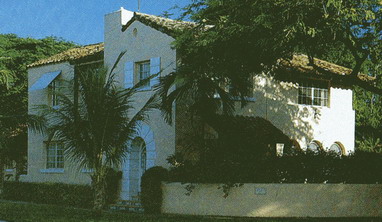 ITALIAN VILLAGE
ITALIAN VILLAGE
Intersection of Monserrate and Altara Avenue; Palmarito and Altara Avenue – Frank Wyatt Woods – 1926
Perhaps it is the quiet location, perhaps the Italian theme in a Mediterranean styled city, that makes the Italian Village the "forgotten" village.
One must look closely at discern its existence and boundaries. Once found, these five stately residences are recognizable by their street-fronting
entrances, walled gardens and exterior door stairways. They were designed in a style typical of Italy's seventeenth century villas and were built
by the Myers Y. Cooper Company for the American Building Corporation.
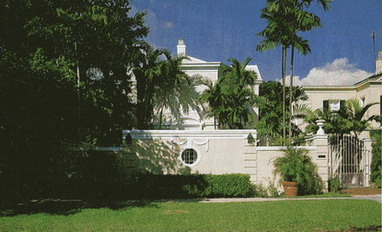 FRENCH CITY VILLAGE
FRENCH CITY VILLAGE
1000 block of Hardee Road – Mott B. Schmidt – 1925-26
Luxurious eighteenth century French townhomes patterned after French Assembly members' versailles residences make up this village. The architect
surrounded this elegant creation with four-foot high walls enclosing lovely courtyards and kitchen gardens. Open-air porches, French doors and
handsome moldings are featured here. The easternmost and westernmost homes on the north side of the block are mirror images of each other, a
repeating pattern which ends with the center residence. Strict city codes require any new structures to conform to the original 1920s exterior.
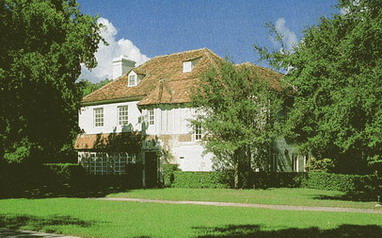 FRENCH COUNTRY VILLAGE
FRENCH COUNTRY VILLAGE
500 block of Hardee Road – Frank Forster, Edgar Albright and Phillip L. Goodwin – 1925-26
Country farmhouse estates and eighteenth century chateaux inspired this village. The homes are large, featuring four bedrooms for the
family living space and two maid's rooms with full baths for servants. All of the residences were built to open, country style, onto big backyards.
Distinctive qualities include round and square towers, carved wood and wrought iron balconies, red brick, keystones and nine and one-half foot
ceilings.
The farmstyled homes were designed by Frank Forster while the rustic ones were designed by Edgar Albright and Phillip L. Goodwin. Many of the
homes were incomplete when virtually all construction ceased after the 1926 hurricane, but because the original plans were available some owners
completed them as they were planned.
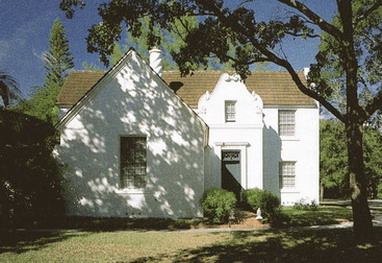 DUTCH SOUTH AFRICAN VILLAGE
DUTCH SOUTH AFRICAN VILLAGE
LeJeune Road, Riviera Drive, Maya Street – Marion Syms Wyeth – 1925
Dignified and elegant, the homes that comprise the Dutch South African Village were patterned on the farmhouses of wealthy Dutch colonists. They are
L-shaped and U-shaped. Exteriors feature circular turned chimneys, high dormed arches, walled gardens, scroll work and steeply pitched roofs.
This village was completed as planned with four homes clustered in a walled compound, one set apart. Marion Syms Wyeth, the creator of this village
and renowned Palm Beach architect, also designed the never-to-be-realized Persian Village and a Persian canal.
In the next newsletter #19 we will feature the buildings in the Residential Walking Tour. This will be part seven.
Your Staff Recommends
For Your Listening & Reading Pleasure
Recommended Listening:
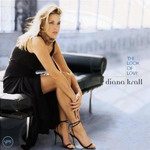 DIANA KRALL:"THE LOOK OF LOVE"
DIANA KRALL:"THE LOOK OF LOVE"
Includes familiar standards like the title song, S'wonderful, Love Letters, Cry Me A River, Besame Mucho,
Dancing In The Dark and more.
Available to purchase or download from www.amazon.com
Recommended Reading:
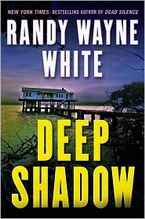 (Doc Ford Series #17)
(Doc Ford Series #17)
Randy Wayne White is the author of sixteen previous Doc Ford novels and four collections of nonfiction. He lives in an old house built on an
Indian mound in Pineland, Florida.
Synopsis:
Doc Ford wrestles more than one kind of demon, in the stunning novel from the New York Times-bestselling author. Many dangers lurk in the deep-
the worst of them are human. Thirty minutes into what should have been an easy, beginner-level dive in a remote Florida lake, the rim of a cave
collapses, trapping two of Doc Ford's friends. Ford himself manages to escape and quickly surfaces to find help-but that's when his troubles
only begin. Two men are waiting for him on the shore, and they are not the kind of men you want to meet at any time. Murderers and ex-cons,
they're intent on diving to the bottom of the very deep lake and uncovering the remains of a legendary plane wreck there, supposedly loaded with
Cuban treasury gold. Ford's expertise is just what they need. And if he doesn't want to help? He can die. His friends? They can die, too. In
fact, they can die right now. . . . As the hours tick away, two mortal struggles unfold simultaneously, one above and one below. Neither
outcome is certain, no man is safe . . . and in the deep shadow, only death awaits.
Reader reviews:
Ok, I have been reading Doc Ford series for years. I love the realism of the books through the use off real locations like Sanibel Island and
the surrounding island off the coast of Florida, and relevant news stories..
I am a first time Randy Wayne White reader and this story was easy to read and kept me on the edge of wanting to know what's in the next chapter.
One of the things that keeps me coming back to an author's books is whether or not the characters and plot are realistic. In short, could one have
actually been there and experienced the plot. Randy Wayne White provides this to the max. One can get absorbed in the plot so as to feel they are
watching characters they feel they know (from previous books).
Available for purchase or download from Barnes & Noble.
Some other Randy Wayne White books:


When the Beach was Hot - Part Three - Final Part
This article was written 17 years ago. It chronicles the hey day of Miami Beach, during
the years we were growing up. It's very long, so we are passing it along in several
installments. This is part three which is the final part.
By Tom Austin Wednesday, Feb 3 1993
"The Beach was full of great characters. Swifty Morgan, the inspiration for that Bob Hope movie, The Lemon Drop Kid, who went around selling
ties in the clubs. Kingfish Levinsky, a punch-drunk ex-fighter who also sold ties and watches as well. He supposedly tried to sell J. Edgar
Hoover a hot watch one time for a hundred bucks, claiming that there was a reward on it for $250. Harry the Hipster, this jazz musician who
used to hang out in the jazz lounges. And of course John Jacob Astor, who was really the black sheep of the family. One of his divorces was
so bad they sealed the court records so it wouldn't leak out to the press.
"It was just a whole different kind of town. Anything could happen. I remember one day on the Beach in high school, walking down the street
with three or four friends. This guy and his wife pulled up in a big Buick convertible and offered us a lift. Who would give a ride to a
bunch of teenagers now? But it was Miami, and that's just the way it was."
Photographer Ray Fisher, now living in South Miami: "It was a very different time; Miami Beach was very elegant, very chic. At the Brook Club
everybody would be in black tie having a gorgeous dinner and watching a show, while gambling went on in the back room. I think it was run by
the S&G Syndicate. The Latin Quarter had glittering, ostentatious stage productions, the kind of thing you might see at Radio City Music Hall.
And all the larger clubs had big orchestras with wonderful musicians.
"I started singing in clubs when I was fifteen, around 1948. I lied and told everybody I was eighteen, and hid it from my parents until I got
caught. I used to sing Broadway show tunes, Spanish songs, and occasionally arias from operas. The first club was the Pago Pago, show tunes
from Carousel, things like that. Fifty bucks a week, a lot of money for a high school kid then. After that I went on to the Brook Club, the Copa,
and the Latin Quarter, when I was seventeen or so, starting college. There was talk about going on to Broadway, but then I got married at eighteen
and a half, and that was that.
"The Latin Quarter came about when Hank Meyer came to our school, looking for somebody to do a publicity stunt with the singer Lenny Ross. They
wanted somebody who could sing opera, which I'd been studying since the age of fourteen, and I did a routine with him, and later Willy Howard.
"Once we did a whole operatic production number based on the second act of La Boheme, the Cafe Momus scene. They had a tenor, I sang the role of
Musetta, and they added showgirls. I'd sing a couple of arias and there'd be a couple of mostly nude girls walking around. After awhile they were
just part of the scenery. Life backstage was an eye-opener, too. We had these two showgirls, the Wyland twins, Winnie and Twinnie, who'd stand on
the side of the stage with nothing on but a white fur muff, both carrying chihuahuas. Thirty years later I was in a box at the Metropolitan Opera
House in New York, and I saw this blond woman on top of a ladder taking pictures. It was Winnie, working as the chief photographer at the Met.
"Usually there'd be two production numbers and then the star would come on. We did two shows a night, and I'd study for school between numbers,
and go home around 3:00 a.m. Then get up the next morning at 8:00 for classes. It was a good experience in not sleeping. I tell everybody now I
hire somebody who sleeps for me.
"A lot of those clubs died when the hotels, places like the Fontainebleau and the Deauville, put in their own nightclubs. Tourists stopped going
out as much. There really aren't any parallels between that time and South Beach now. We're getting back to it, the Beach is alive and moving
again, but it was much more glamorous then. Now it's a younger crowd. A Latin Quarter today would be packed, though. The time for it has come
back."
Judy Drucker, head of the Concert Association of Florida:
"The late Forties to mid-Fifties A those were the days. No cocaine or crack, and you really didn't have to lock your doors. It was a golden age
after the Second World War. There was always gambling, at places like the Royal Palm Club [on Palm Island], which went on well after the Kefauver
committee hearings. There weren't too many charity balls, or an opera house, but plenty of wonderful theme galas at the Bath and Surf clubs:
beautifully dressed elegant people, not tacky in any way. In season you had the royals and their crowd. Lucy Cotton, a former silent-screen star
who married the Russian Prince Eristavi Tcherine... everybody called her Princess Lucy. Prince Rospigliosi, an Italian nobleman, and his wife
Elizabeth. The General Motors bunch, the Detroit ladies, wore big hunky jewelry. No one was afraid of being robbed, although I do remember driving
up to Hollywood one night in an open convertible and some thugs actually did try to pull us over. I was traveling with a society lady wearing a
huge diamond necklace, and her boyfriend, who was an accountant with the Chicago mob. But we got away. No real traffic then, either, and it was
nothing to go to all the slumming bars in downtown Miami... you'd take off just like that. It was a sweet town.
"The Latin Quarter had revues with cancan girls shrieking and lifting their skirts. I still remember one acrobatic act, Darvus and Julia: This
woman would climb up a ladder, jump, and do a split on top of a glass floor. Then there were all the gambling clubs up in Golden Beach and
Hollywood...Tony Martin would play up there sometimes. The Roney was chic then, and Alfred Barton threw elaborate, sky's-the-limit parties
at the Surf Club, with elephants and tigers and circuses. When he died, the whole thing fell apart. The Brook Club, where they had gambling,
was very high-class A long gowns and white dinner jackets. Some of the private parties in homes around town were very decadent, but everyone
was well behaved, even when they had too many drinks. John Jacob Astor had a big house on Pine Tree Drive, and he'd have huge parties, everyone
in formal wear, with various entertainments: female wrestlers in bras and panties, rolling around on slick canvases.
"It was the beginnings of Dorothy Dey, who was a gossip columnist for the Hearst Syndicate. She and John Jacob Astor both survived the sinking
of the Titanic, when Dorothy was a kid, and then she went on to start the "Suzy" column. Into the Sixties, it was a wide-open town, and Dorothy
was the first nationally known gossip columnist based here. The column was called "Night and Dey," and she knew everybody in American society A
celebrities, phonies, everybody. She'd dish them, but she wrote a bitch column like a lady. I really miss her.
"Society was a real melange then. Helen and her brother John were both on Pine Tree, the Firestones right on the beach where the Fontainebleau
is now, and then there were all the enormously rich Cubans, like Julio and Jorge Sanchez A two sugar barons who lived on Star Island. On all
the private estates, people entertained lavishly: sit-down dinners for 200 or 300, with party tents and orchestras. There were religious
differences, of course, but people like Audrey Ruxton Love...a Guggenheim...were members at the Surf Club, for instance.
"When I was financially able to, I had my own parties for 200 or so at my place in the Venetian Islands. Before he moved to Star Island, Dan
Paul had a three-and-a-half-acre waterfront estate on Key Biscayne, the old Matheson place. He always had wonderful parties. I still remember
one of his New Year's Eve things on Star Island. People don't entertain like that any more.
"And there was always Cuba on the weekends. I remember going down to visit Doris Hedges in Havana... her husband Burke was ambassador to Brazil
at the time...and going to the Barletta cräme-de-la-cräme wedding, when she married Count Somebody or another. There was a beautiful party on
her estate with the Havana Symphony playing dance music. It was right before Castro took over, and all these guards with machine guns were
crouched in the bushes.
"Everything has changed, the elegance of the private clubs, the parties. When they ended gambling, the chic people went somewhere else. I still
have fun, though. Waking up in the morning and still being alive... that's fun to me now."
Clothing designer Jay Anderson, retired and living in Coconut Grove: "I came down here in 1940. I've owned Wolfie's for eight years. At that
time the Roney was the northern end of civilization; there wasn't much above 23rd Street. In the Wolfie's space was a neighborhood bar called
Fan and Bill's. They took over the club next door and made it into a really grand nightclub, also called Fan and Bill's, with singers and
shows. Everybody went there. Then it became Chandler's restaurant, a very elegant supper club. Wolfie Cohen took over this space in '42 or '43,
and it was popular from the start, lines around the block, 24-hour service. Tourists, locals who'd come by after the fights at the Fifth Street
gym, and every major star. In our celebrity room we have pictures of Clark Gable, Spencer Tracy, Lionel Barrymore, Katharine Hepburn. People
would show up in chauffeured limousines. It was quite a scene."
Joseph Nevel, current owner of Wolfie's restaurant: "I moved down from New York, where I'd been involved in theater, in the late Fifties, and
started handling the Empress Hotel at 43rd and Collins. I just sort of fell into being a press agent. Then I went to work for Patsy Abbott,
who had a club called Patsy's Place. It was hot, sophisticated, and rocking. One night Elizabeth Taylor and Mike Todd walked in. The newspapers
had room for that kind of stuff then, and every night photographers and columnists ...Herb Rau of the News, George Burke from the Herald...would
travel around the clubs looking for material. George didn't drive, and did the whole route by bus. I'd be dropping photos off at the papers and
I'd see him waiting on Collins Avenue in the middle of the night and wind up giving him a lift somewhere. Then you had the smaller papers, the
Post Mortems and Antennas of their day, working the same turf.
"Usually I'd try to set up interviews with celebrities, or get one of the roving photographers to come over, or have my own guys shoot stuff.
It was still very hard to crack the columns then, a real achievement. The press would come by, try to catch a celebrity misbehaving, schnorrer
around, get a free meal. Just like today, I guess.
"Over on 23rd Street there were the three clubs owned by Teddy Goldstein, who was tied in with that whole Birdland crowd in New York. It's a
parking lot now, I think. They were all connected, but each of them...the Pin Up, the Grate, the Nite Owl... had a different ambiance. The
Grate was a jazz lounge, thumb bits for snacks and great musicians...Chet Baker played there. The other two had jukeboxes, which were very
important in those days. Mostly sentimental music, Judy Garland and Bobby Short. The Pin Up played a lot of Frank Sinatra. The Nite Owl was
the last stop of the night, a real set-'em-up-Joe kind of place.
"Up on the 79th Street Causeway you had the Bonfire, a pick-up joint. Rip Taylor started out up there. At the Seagull Hotel on 21st Street
there was a late-night disc jockey called Sleepytime Gal, operating out of one of the rooms. People would come by and talk to her, and she'd
play Tony Martin records all the time. Martin was like an obsession with her. She was great, really ahead of her time.
"There was a hotel of the year, every year...the Eden Roc, Fontainebleau, whatever. The lobbies would blow your mind; people would go over
just to look at them. What really ruined things was the American plan, which meant tourists ate three meals a day at the hotel and then stayed
in for the shows at night.
"Miami Beach was the resort town in the winter. To be here in the height of the season meant you had money. It was really part of that
borscht-belt circuit: summers in the Catskills, winters on Miami Beach. The Broadway Series is bringing a show down this season, Catskills
on Broadway (the revue opened last week and runs through February 7 at the Jackie Gleason Theater) with all the comedians who used to play
down here: Freddie Roman, Mal Z. Lawrence, Dick Capri, and Louise DuArt. People are still aching for that kind of humor.
"The excitement of those times was unbelievable. You never saw anything like the parade of jewels and furs. The town was full of high-rollers.
It was all about eating, drinking, gambling, and getting a tan. And people definitely came down here to connect. You'd have women in the Boom
Boom Room at the Fontainebleau trying to find a rich husband. Some of those women married very well and are quite respectable now. The town
was flamboyant, outrageous, and ultimately very glamorous."
Publicist Charlie Cinnamon: "Miami Beach in the Fifties was far better than now. Men wore hats and jackets, ladies all had mink stoles and
gloves, everybody always dressed up for dinner. People even go to nice restaurants in jeans now. The whole country is more casual and
downscaled than it was then.
"In season, stars were everywhere. You'd see Lana Turner and Susan Hayward shopping at Saks on Lincoln Road. At night they'd have the whole
Rat Pack at the Fontainebleau: Frank Sinatra, Dean Martin, Sammy Davis, Jr., Peter Lawford. Afterwards they'd all go to the clubs. There was
Murray Franklin's on 23rd Street, where all the performers would come in after their shows. They had risque comedians, that kind of stuff.
It was a riot, really sensational.
"The Patio Club on Dade Boulevard, I think it's a gas station now, was a little quaint after-hours place. I was in there one night when
Frank Sinatra and Joe Di Maggio walked in; Winchell came in a lot, too. Joe and Ethel Stein owned the Jewel Box, and it was a very classy
kind of place, absolutely gorgeous female impersonators, a mixed gay and straight crowd.
"The Saxony and the Sans Souci were the two largest hotels then. The restaurants were wonderful. Joe's, of course, was always crowded. Morris
and Ruth Lerner had The Famous, where The Strand is now, and it was great: kosher food, kreplach and things like that, seltzer bottles on the
table. The Park Avenue on Twentieth Street was a very nice steak house, and then you had the Embers, where Club Nu is now. They served delicious
spiced apples with every dish. First class. Jacket and tie required. Then Wolfie's for deli food, all the waitresses in starched white uniforms
with big pocket handkerchiefs.
"Lincoln Road was more upscale than lower South Beach, and it seems to me that you still had a lot of older people down there. I lived on
Pennsylvania and Tenth. Unfortunately it was also a time of restricted hotels and apartments. The Kenilworth didn't allow Jews, as well as
some of the buildings on South Beach. "You still have celebrities from New York coming here, and royalty, but you don't get wonderful people
anymore. They act differently than they used to. It seems like the whole world was more grand in those years than it is now."
(End Part Three - Final Part. Part One and Part Two may be found in the Newsletter archive.)
|


 COLONIAL VILLAGE
COLONIAL VILLAGE FRENCH NORMANDY VILLAGE
FRENCH NORMANDY VILLAGE CHINESE VILLAGE
CHINESE VILLAGE ITALIAN VILLAGE
ITALIAN VILLAGE FRENCH CITY VILLAGE
FRENCH CITY VILLAGE FRENCH COUNTRY VILLAGE
FRENCH COUNTRY VILLAGE DUTCH SOUTH AFRICAN VILLAGE
DUTCH SOUTH AFRICAN VILLAGE DIANA KRALL:"THE LOOK OF LOVE"
DIANA KRALL:"THE LOOK OF LOVE"
 (Doc Ford Series #17)
(Doc Ford Series #17)

